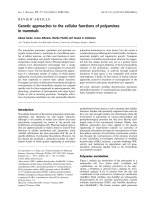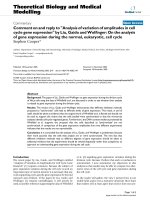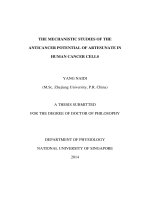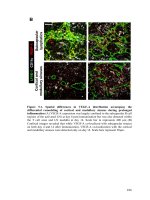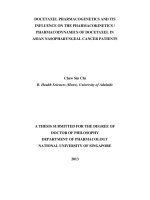Functions of deleted in liver cancer (DLC1) in cell dynamics
Bạn đang xem bản rút gọn của tài liệu. Xem và tải ngay bản đầy đủ của tài liệu tại đây (7.23 MB, 197 trang )
FUNCTIONS OF DELETED IN LIVER CANCER 1 (DLC1)
IN CELL DYNAMICS
ZHONG DANDAN
(B.Sc, Xiamen University, China)
A
THESIS SUBMITTED
FOR THE DEGREE OF DOCTOR OF PHILOSOPHY
DEPARTMENT OF BIOLOGICAL SCIENCES
NATIONAL UNIVERSITY OF SINGAPORE
2008
ACKNOWLEDGEMENTS
I would like to express my deepest gratitude and appreciation to my supervisor, A/P Low
Boon Chuan, for his advice, criticisms, encouragements and guidance along my way in
graduate study and research.
I wish to thank Dr. Zhou Yiting and Dr. Jan Paul Buschdorf for their constant assistant
and valuable suggestion through the years.
I would like to thank A/P Yang Daiwen, Yang Shuai and Dr. Zhang Jinfeng for their
collaboration, discussion and assistance in the research of this thesis.
I am very grateful to all current and past colleagues in A/P Low’s laboratory. They are: Dr.
Zhou Yiting, Dr. Jan Paul Buschdorf, Dr. Liu Lihui, Tan Jee Hian, Dr. Soh Jim Kin, Dr.
Lua Bee Leng, Dr. Shang Xun, Chew Li Li, Zhu Shizhen, Dr. Liu Xinjun, Tan Shui Shian,
Soh Fu Ling, Aarthi Ravichandran, Pan Qiu Rong, Sharmy Jennifer James, Chew Ti
Weng, Chin Fei Li, Leow Shu Ting, Lim Gim Keat, Toh Pei Chern and Teo Ai Shi.
I would like to acknowledge the National University of Singapore for awarding me the
research scholarship.
Finally, I want to thank my families. I owe my dearest thanks to my mother Deng
Xiaoling and my husband, Liu Jinhui for their love, support and encouragement all the
way in my study and my life.
Zhong Dandan
Jan.2008
ii
TABLE OF CONTENTS
TITLE PAGE i
ACKNOWLEDGEMENTS ii
TABLE OF CONTENTS iii
SUMMARY ix
LIST OF FIGURES x
LIST OF TABLES xii
LIST OF ABBREVIATIONS xiii
SYMPOSIA PRESENTATION
CHAPTER 1 INTRODUCTION
1.1 Rho GTPase family 1
1.1.1 The Rho GTPase cycle 2
1.1.1.1 Mechanism of the Rho GTPase cycle 2
1.1.1.2 Regulators in the RhoGTPase cycle 3
1.1.2 Cellular functions of Rho GTPases 5
1.1.2.1 Rho GTPases are key regulators of actin cytoskeleton 5
1.1.2.2 Rho GTPases in cell adhesion and cell migration control 6
1.1.2.3 Rho GTPases in cell cycle control 7
1.1.2.4 Rho GTPases in oncogenesis 8
1.1.3 The downstream effectors of Rho GTPases 9
1.1.3.1 Effectors targeting Rho 9
iii
xv
1.1.3.2 Effectors of Rac and Cdc42 10
1.2 The RhoGAP family 11
1.2.1 Structural mechanism of the Rho GTPase-downregulation by
RhoGAPs
11
1.2.2 The complexity of RhoGAPs for the regulation towards Rho
GTPases
12
1.2.3 Cellular functions of RhoGAPs 14
1.2.3.1 RhoGAPs in cell migration 14
1.2.3.2 RhoGAPs in endocytosis and molecule trafficking 14
1.2.3.3 RhoGAPs in cell growth, apoptosis and differentiation 15
1.2.3.4 RhoGAPs in tumor suppression 16
1.2.3.5 RhoGAPs in neuronal morphogenesis
1.2.3.6 Crosstalks of Rho GTPase pathways and other signaling
pathways mediated by RhoGAPs
17
1.2.4 The regulation on RhoGAPs 18
1.3 DLC1 as a novel RhoGAP protein 19
1.3.1 Homologues of human DLC1 20
1.3.2 Essential function of DLC1 in embryonic development 22
1.3.3 DLC1 as a tumor suppressor 22
1.3.4 DLC1 as a mutidomain RhoGAP 25
1.3.4.1 The RhoGAP domain of DLC1 27
1.3.4.2 The SAM domain of DLC1 29
1.3.4.3 The START domain of DLC1 31
1.3.5 Molecular mechanism of DLC1 in cell dynamics 34
1.4 Hypothesis and objectives of this study 35
iv
CHAPTER 2 MATERIALS AND METHODS
2.1 RT-PCR cloning and plasmid construction 37
2.1.1 RNA isolation and RT-PCR 37
2.1.2 Cloning of the DLC1 and EF1A1 constructs 39
2.1.3 Cloning of deletion mutants and point-mutation mutants of DLC1 40
2.2 Identification of DLC1-interacting partners 41
2.3 Cell culture and transfection 42
2.4 Precipitation/pull-down and co-immunoprecipitation studies 43
2.4.1 Mammalian cell lysate preparation 43
2.4.2 Preparation of GST-fusion proteins for pull-down experiments 43
2.4.3 Precipitation/pull-down 44
2.4.4 Co-immunoprecipitation 44
2.4.5 G-actin in vitro binding studies 44
2.5 Direct binding studies 45
2.6 RBD assay 46
2.7 SDS-PAGE gel eletrophoresis and western blot analysis 46
2.8 Pyrene Actin polymerization assay 48
2.9 Immnofluorescence 49
2.10 Cell migration assay 50
v
CHAPTER 3 RESULTS
3.1 Cloning of DLC1 50
3.2 Identifying EF1A1 as a novel interacting partner of DLC1-SAM
domain
52
3.2.1 Multiple sequence alignment of various SAM domains 53
3.2.2 DLC1-SAM does not mediate homophilic interaction 55
3.2.3 EF1A1 is a novel DLC1-interacting partner 57
3.2.4 Two distinct motifs of EF1A1 are involved in binding to
DLC1-SAM
67
3.2.5 Identifying key EF1A1-binding motif in DLC1-SAM 71
3.2.5.1 Prediction of putative EF1A1-binding motif in DLC1-SAM 71
3.2.5.2 Residues F38 and L39 constitute key EF1A1-binding motif on
DLC1-SAM
73
3.2.6 DLC1-SAM facilitates dynamic disposition of EF1A1 to cell
periphery
78
3.2.6.1 Effects of DLC1-SAM on actin-binding and polymerization 78
3.2.6.2 SAM domain mediates dynamic disposition of DLC1 with
EF1A1 on cortical actin and membrane ruffles
82
3.2.7 DLC1-SAM domain plays an auxiliary role in suppressing cell
migration
90
3.3 Identifying BNIP-Sα as a novel interacting partner of DLC1
93
3.3.1 Interaction of DLC1 with BCH domain-containing proteins 93
3.3.2 Identifying key DLC1-interacting motif on BNIP-Sα
95
3.3.2.1 BCH domain of BNIP-Sα is important for the interaction with
DLC1
95
3.3.2.2 GAP-binding motif in BNIP-Sα-BCH is important for its
98
vi
interaction with DLC1
3.3.3 Identifying key BNIP-Sα-interacting motifs on DLC1
102
3.3.3.1 Multiple regions in DLC1 are involved in binding to BNIP-Sα
102
3.3.3.2 DLC1-START domain has binding affinity towards BNIP-Sα
106
3.3.3.3 DLC1-P1 and P3 sequences have binding affinity towards
BNIP-Sα
108
3.3.3.4 Deletion in DLC1-P3 lost the function in changing cell
morphology
112
3.3.3.5 DLC1-P3 was strongly enriched by BNIP-Sα in in vitro direct
binding
115
3.4 DLC1-P3 is important for the function of DLC1 117
3.4.1 DLC1-∆P3 and DLC1-R677E have similar effect in cell
morphology
117
3.4.2 DLC1-∆P3 retains in vivo GAP activity towards RhoA 119
3.4.3 Deletion in DLC1-P3 strongly affects its ability to suppress cell
migration
122
CHAPTER 4 DISCUSSION
4.1 A novel function for the SAM domain of DLC1 125
4.2 The molecular mechanism of the interaction between DLC1-SAM
and EF1A1
126
4.3 Implications of DLC1 interacting with EF1A1, a central regulator for
cell metabolism and signaling
128
vii
4.4 Implications of DLC1 as a novel BCH domain-interacting partner 136
4.5 The molecular mechanism of the interaction between DLC1 and
BNIP-Sα
138
4.6 Functional implications of DLC1 interacting with BNIP-Sα
141
4.7 DLC1-P3 region is a novel regulatory module for the function of
DLC1
143
4.8 Conclusions and future perspectives 147
CHAPTER 5 REFERENCES 153
viii
SUMMARY
Deleted in Liver Cancer-1 (DLC1) is a multi-modular Rho GTPase-activating
Protein (RhoGAP) and a tumor suppressor. In this study, the identification of eukaryotic
elongation factor-1A1 (EF1A1) and BNIP-2 similar isoform alpha (BNIP-Sα) as two
novel interacting partners of DLC1, the molecular mechanism and the functional
significance of the interaction between EF1A1 and DLC1 will be presented.
DLC1 harbors 3 distinctive domains, i.e. the Sterile-Alpha Motif (SAM) at its
N-terminus, the Steroidogenic Acute Regulatory-related Lipid Transfer (START) domain
at the C-terminus and a conserved RhoGAP (GAP) domain close to the middle of the
protein. Besides its RhoGAP domain, functions of other domains in DLC1 remain largely
unknown. In my current study, EF1A1 was identified as a novel binding partner of
DLC1-SAM domain by protein precipitation and mass spectrometry. Residues F38 and
L39 within a hydrophobic patch on DLC1-SAM domain were identified as an
indispensable EF1A1-interacting motif. DLC1-SAM recruits EF1A1 to membrane
periphery and ruffles which plays an auxiliary role in DLC1’s function in cell motility
suppression. My current study also presents the novel interacting activity between the
BNIP-2 and Cdc42GAP homology (BCH) domain of BNIP-Sα and DLC1. Three
BNIP-Sα-interacting regions on DLC1 were delineated, including the START domain and
two N-terminus regions between the SAM domain and the GAP domain. These findings
shed light on the mechanisms of how other motifs of DLC1 cooperate with the RhoGAP
activity to modulate DLC1’s function in cell dynamic control.
ix
LIST OF FIGURES
Figure 1.1
20 Rho GTPases can be divided into five subfamilies, Rho-like,
Rnd, Cdc42-like, Rac-like, and RhoBTB.
1
Figure 1.2
The Rho GTPase cycle mediates cellular response downstream
of extracellular stimuli.
3
Figure 1.3
Roles of Rho, Rac, and Cdc42 in actin cytoskeleton organization. 6
Figure 1.4
Phylogenic tree of the RhoGAP family. 13
Figure 1.5
Schematic diagram showing the composition of protein domains
for human DLC1.
27
Figure 3.1
Molecular cloning of human DLC1 cDNA. 51
Figure 3.2
Schematic diagram showing the composition of protein domains
of different truncation mutants of DLC1 protein.
52
Figure 3.3
Homology of DLC1-SAM with other SAM domains of known
structures/binding properties.
54
Figure 3.4
The SAM domain of DLC1 does not mediate homophilic
interaction.
56
Figure 3.5
Identification of Elongation Factor 1A1 as a novel partner of
DLC1.
59
Figure 3.6
EF1A1 binds to full length DLC1 and DLC1-SAM in vitro and
in vivo.
62
Figure 3.7
EF1A1 directly binds to full length DLC1 and DLC1-SAM. 66
Figure 3.8
DLC1-SAM binds to distinct domains of EF1A1 in vitro and in
vivo.
69
Figure 3.9
Putative EF1A1-binding motifs in DLC1-SAM. 72
Figure 3.10
Identifying EF1A1-binding motif in DLC1-SAM. 75
Figure 3.11
Interaction of DLC1-SAM with globular actin in vitro. 79
Figure 3.12
DLC1-SAM does not affect actin polymerization in vitro. 80
Figure 3.13
DLC1-SAM domain facilitates recruitment of EF1A1 to 85
x
membrane periphery and membrane ruffles.
Figure 3.14
Effects of DLC1-SAM on cell migration. 92
Figure 3.15
DLC1 could form complexes with BNIP-Sα and BNIP-2.
94
Figure 3.16
BNIP-Sα-BCH domain is important for the interaction with
DLC1.
96
Figure 3.17
GAP-binding motif in BCH domain is important for the
interaction with DLC1.
100
Figure 3.18
Multiple regions in DLC1 are involved in the binding to
BNIP-Sα.
104
Figure 3.19
Both DLC1-N terminus and -C terminus specifically target
BNIP-Sα-BCH domain.
105
Figure 3.20
The START domain of DLC1 has affinity towards BNIP-Sα.
107
Figure 3.21
DLC1-P1 and DLC1–P3 region has affinity towards BNIP-Sα.
110
Figure 3.22
Schematic diagrams showing the regions on DLC1 and BNIP-Sα
with binding affinity towards each other.
113
Figure 3.23
Effects on cell morphology of DLC1 mutants deleted in different
BNIP-Sα-interactive regions.
114
Figure 3.24
DLC1-P3 directly binds to BNIP-Sα-BCH in vitro.
116
Figure 3.25
DLC1-∆P3 could not induce stress fiber dissociation and cell
shrinkage as DLC1 full length.
118
Figure 3.26
The in vivo GAP activity of different DLC1 mutants towards
endogenous RhoA.
121
Figure 3.27
Effects of different DLC1 mutants on cell migration. 124
Figure 4.1
Implications of DLC1 and EF1A1 interaction on cell dynamics
and cell growth control.
134
Figure 4.2
Putative phosphorylation sites in DLC1-P3 region. 145
xi
LIST OF TABLES
Table 2.1
Primers used for the cloning of DLC1 full length and domains. 37
Table 2.2
Primers used for the cloning of DLC2 SAM domain. 38
Table 2.3
Primers used for the cloning of EF1A1 full length and domains. 39
Table 2.3
Primers used for DLC1 deletion mutants and point mutation
mutants preparation.
41
xii
LIST OF ABBREVIATIONS
BCH domain: BNIP-2 and Cdc42GAP homology domain
BNIP-2: Bcl2/adenovirus E1B 19D interacting Protein 2
BNIP-H: BNIP-2 Homology
BNIP-Sα: BNIP-2 Similar alpha
bp: base pair
BSA: bovine serum albumin
Cdc42: Cell Division Cycle 42
DAG: diacylglycerol
DLC1: Deleted in Liver Cancer 1
DMEM: Dulbecco’s modified eagle medium
DNA: deoxyribonucleic acid
EF1A1: Elongation Factor 1A1
F-actin: filamentous actin
G-actin: globular actin
GAP: GTPase Activating Protein
GFP: Green Fluorescent Protein
GST: Glutathion S-transferase
GTP: Guanosine Triphosphate
HCC: hepatocellular carcinoma
IP: immunoprecipitation
IP
3
, inositol-3,4,5-triphosphate
IPTG: isopropyl-thiogalactoside
Kb: kilobase
kD: kilodalton
l: litre
M: molarity, moles/dm
3
mg: milligram
xiii
min: minute
ml: millitre
mM: molarity, millimoles/dm
3
MW: molecular weight
OD: optical density
PAGE: polyacrylamide gel electrophoresis
PBS: phosphate buffered saline
PCR: polymerase chain reaction
PD: pull-down
PI(4)P: phosphatidylinositol-4-phopshate
PI(4,5)P
2
: phosphatidylinositol-4,5-bisphopshate
PIP
3:
phosphatidylinositol-3,4,5-bisphopshate
PLC: phospholipase C
Rac1: Ras-related C3 Botulinum Toxin Substrate 1
RhoA: Ras homologous member A
rpm: rotation per minute
SAM: Sterile Alpha Motif
SDS: sodium dodecyl sulfate
Sec: second
START: STAR-related lipid-Transfer
U: unit
µg: microgram
µl: microlitre
v/v: volumn by volumn
w/v: weight by volumn
WCL: whole cell lysate
X-gal: 5-bromo-4-chloro-3-indolyl-β-D-galactopyranoside
xiv
SYMPOSIA PRESENTATION
1. Zhong D, Low BC. Dissecting the Molecular Mechanism Underlying Cell
Dynamics Control by Deleted in Liver Cancer 1 Protein (DLC1). Oral presentation.
9th Biological Science Graduate Congress, Chulalongkorn University, Bangkok,
Thailand, December 16-18th, 2004.
2. Zhong D, Low BC. Dissecting the Molecular Mechanism Underlying Cell
Dynamics Control by Deleted in Liver Cancer 1 Protein (DLC1). Third
International Conference on Structural biology & Functional Genomics, Singapore,
December 2-4th, 2004.
3. Zhong D, Low BC. Understanding the Role of Sterile Alpha Motif (SAM) Domain
for the Function of DLC-1. 8th Biological Science Graduate Congress, Department
of Biological Sciences, National University of Singapore, Singapore, December
3-6th, 2003.
xv
Chapter 1
Introduction
1.1 Rho GTPase family
Ras homologous (Rho) GTPases comprise a family of small guanosine triphosphatases
(GTPases), which belong to the Ras GTPases monomeric G protein superfamily. To date,
more than 20 members of Rho GTPases have been identified in humans (Wennerberg et
al., 2005). Based on their primary sequences and known functions, Rho GTPases can be
roughly divided into 5 groups, the Rho-like, Rac-like, Cdc42-like, Rnd, and RhoBTB
subfamilies (Figure 1.1) (Burridge and Wennerberg, 2004). RhoA, Rac1, and Cdc42 are
the three best studied Rho GTPases (Hall, 2005). The following parts in the introduction
will focus on their functions and the underlying molecular mechanisms in cell dynamic
control.
1
Figure 1.1 20 Rho GTPases can be divided into five subfamilies, Rho-like, Rnd,
Cdc42-like, Rac-like, and RhoBTB. (Adapted from Burridge and Wennerberg, 2004.)
1.1.1 The Rho GTPase cycle
1.1.1.1 Mechanism of the Rho GTPase cycle
Each Rho GTPase contains one conserved G domain of around 20kDa, which
can bind to GDP/GTP. With their G-domains, Rho GTPases can cycle between active
GTP-bound state and inactive GDP-bound state like binary molecular switches (Figure
1.2) (Vetter and Wittinghofer, 2001).
RhoGTPases bind to GDP/GTP with a common biochemical mechanism. The
G-domain of Rho GTPases folds into a conserved α/β structure forming a shallow surface
pocket that accommodates guanine nucleotide (Scheffzek and Ahmadian, 2005). The
binding to guanine nucleotide involves three regions in the G domain, including Switch I
region, Switch II region and P-loop. Switch I and II regions contact γ-phosphate directly
in the GTP-bound state, which results in considerable conformational difference of the
G-domain compared to the GDP-bound state. Such conformational difference in the
active state of Rho GTPases can be recognized by down-stream effectors, which only
bind to and are activated by the active Rho GTPases. The G domain also has intrinsic
GTPase ability to hydrolyze the bound GTP into GDP. But this intrinsic reaction is very
slow. After the GTP hydrolysis, Rho GTPases return to the inactive state and terminate
2
downstream signaling. To turn back into activited status, the tightly-bound GDP on Rho
GTPses then has to be released for the exchange of the next GTP (Scheffzek and
Ahmadian, 2005).
1.1.1.2 Regulators in the RhoGTPase cycle
The transitions between the two states of Rho GTPases are regulated by three
types of molecules inside the cell: guanine nucleotide exchange factors (GEFs), GTPase
activating proteins (GAPs) and guanine nucleotide dissociation inhibitors (GDIs). When
Rho proteins are in active state, they can interact with downstream effectors and lead to
cellular effects (Figure 1.2).
Figure 1.2 The Rho GTPase cycle mediates cellular response downstream of
extracellular stimuli. The cycle is regulated by GEFs, GAPs and GDIs. When Rho
3
GTPases are in active state, they can interact with effectors and lead to cellular response.
(Adapted from Jaffe and Hall, 2005.)
GEFs are activators of Rho GTPases. In the Rho GTPase cycle, the GDP-GTP
exchange reaction is the rate limiting step. GEFs catalyze the exchange of GDP for GTP
by increasing the rate of GDP dissociation from Rho proteins (Erickson and Cerione,
2004). GEFs activate Rho GTPases upon the stimulation of growth factors and some
extracellular agents. There are 85 GEFs found in human genome. Since the upregulation
of many Rho GTPases contributes to oncogenesis, there is no wonder why many GEFs, as
the activators of Rho proteins, were identified as oncogenes (Hall, 2005).
RhoGAPs are negative regulators of Rho GTPases. In the active state of Rho
GTPases, the GTP-hydrolysis by the intrinsic activity of its G-domain is very slow. The
inactivation of Rho GTPases by RhoGAPs is achieved by stimulating the GTPase activity
of Rho GTPases and promoting the hydrolysis of bound GTP to GDP.
GDIs form in complexes with Rho GTPases to regulate their intracellular
localizations and block their downstream cellular effects (Olofsson, 1999). GDIs conduct
three kinds of biochemical activities on Rho GTPases to downregulate the biological
effects of Rho proteins. First, they keep Rho GTPases in inactive states, by inhibiting the
dissociation of GDP from Rho GTPases and blocking the activation by GEFs. Second,
GDIs interact with GTP-bound Rho proteins, inhibiting GTP hydrolysis and blocking
their interaction with downstream effectors. Third, GDIs can regulate the cycling of Rho
4
GTPases between cytosol and membranes where such effectors are located
(DerMardirossian and Bokoch, 2005).
1.1.2 Cellular functions of Rho GTPases
Rho GTPases are key regulators down-stream of extracellular-stimuli that
regulate a diverse set of biological activities, including cytoskeleton organization, vesicle
transport, cell polarity, cell cycle progression, gene expression, enzymatic activation,
differentiation and oncogenesis (Etienne-Manneville and Hall, 2002).
1.1.2.1 Rho GTPases are key regulators of actin cytoskeleton
The first characterized function of Rho GTPases is their regulation on
cytoskeleton reorganization. Rho GTPases are key regulators of actin cytoskeleton that
link extracellular signals and cell surface receptors to the dynamic organization of actin
cytoskeleton. It is well known that Rho regulates the formation of contractile
actin-myosin filaments to form stress fibers and the assembly of focal adhesion
complexes in response to lysophosphatidic acid (LPA) or integrin engagement. Rac
induces actin polymerization that lead to the assembly of a meshwork of actin filaments at
the cell periphery to form sheet-like lamellipodia and membrane ruffles in response to
platelet-derived growth factor (PDGF), epidermal growth factor (EGF) or insulin. Cdc42
triggers actin filament assembly and bundling at the cell periphery to form actin-rich
5
protrusions on the cell surface called filopodia or shorter protrusions call microspikes in
response to bradykinin and interleukin 1 (IL-1) (Figure 1.3) (Alberts et al., 2002; Hall,
1998; Nobes and Hall, 1995; Hall, 2005).
Figure 1.3 Roles of Rho, Rac, and Cdc42 in actin cytoskeleton organization.
Compared with quiescent cells (-), active Rho induces the formation of stress fiber and
focal adhesion
while active Rac and active Cdc42 induce the formation of lamellipodia
and filopodia respectively. Actin filaments were shown in A, C, E and G and adhesion
complexes were shown in B, D, F, and H. (Adapted from Hall, 1998.)
1.1.2.2 Rho GTPases in cell adhesion and cell migration control
Cytoskeleton makes up the framework for eukaryotic cells. Dynamic
reorganization of cytoskeleton is the basis of many other cellular activities, such as
vesicle trafficking, cell adhesion, endocytosis, cell migration and morphological changes
during the process of apoptosis. The key roles of Rho GTPases on cytoskeleton
6
reorganization are closely related to their ability in the regulation of other cellular
activities coordinate with actin dynamics, including cell adhesion and cell migration. For
cell adhesion, Rho activity is required in the assembly of integrin-based focal complexes
in cell attachment to extracellular matrix. Besides, Rho GTPases regulate the formation
and maintenance of cadherin-based cell-cell adhesion complexes (Hall, 1998; Malliri and
Collard, 2003). For cell migration, dynamic rearrangement of cytoskeleton provides the
driving force for migration in animal cells. In this process, actin polymerization and
filament elongation at the front and actin:myosin filament contraction at the rear are
required for directed cell migration in vivo, which are controlled by the coordinate
regulation of Rac, Rho and Cdc42. Active Rac accumulates at the front of migrating cells
to form lamellipodia and membrane ruffles to push forward the leading edge membrane.
Rho induces stress fibers and generates contractile forces at the rear of the cells to move
cell body forward. Cdc42 senses the extracellular cues and establishes the cell polarity,
which determines the localization of active Rac and makes the cell movement directional
(Jaffe and Hall, 2005). In addition to actin dynamics, Rho GTPases also regulate
microtubule dynamics involved in cell migration (Malliri and Collard, 2003).
1.1.2.3 Rho GTPases in cell cycle control
Rho GTPases also play important roles in cell cycle progression. First, they
contribute to G1 phase progression. Second, Rho GTPases are crutial for the
reorganization of the microtubule and actin cytoskeletons during M phase (Jaffe and Hall,
7
2005). The importance of Rho GTPases in cell cycle control is further supported by the
evidence that their activities are essential for Ras-induced cell transformation (Hall, 1998).
The roles of Rho GTPases in cell cycle control implicate that their deregulation will
consequently contribute to malignant transformation and cancers (Villalonga and Ridley,
2006).
1.1.2.4 Rho GTPases in oncogenesis
Besides the role of Rho GTPases in cell cycle control, their functions in
cytoskeleton reorganization, cell adhesion, migration and gene expression also contribute
to oncogenesis. Deregulation of Rho GTPases contributes to the growth, survival and
invasiveness of tumor cells. There have been many evidences showing aberrant Rho
signaling or elevated Rho expression in the formation and progression of tumors. Early
indications of the role of Rho GTPases in oncogenesis came from in vitro transformation
studies of fibroblasts. Constitutively active Rac1 (V12Rac) and RhoA (V14RhoA) or
overexpression of Rho proteins were able to transform normal cells (Prendergast et al.,
1995; van Leeuwen et al., 1995). The transforming capacity of Rho GTPases is correlated
with the fact that they mediate downstream effects of oncogenic Ras activity in tumors
(Khosravi-Far et al., 1995). It is now clear that Rac signaling is required for oncogenic
Ras-induced tumorigenesis, in which Rac stimulates cell growth and enhances cell
survival under cellular stress (Joneson and Bar-Sagi, 1999). More recently, in vivo studies
using knockout and transgenic mice of various Rho GTPases demonstrated that the
8
deregulation of Rho GTPases contributes to various aspects of oncogenesis besides
transformation. Rho GTPases affect the process of tumor invasion/metastasis through
their pivotal roles in cytoskeleton organization, cell-cell adhesion and migration (Malliri
et al., 2002; Hakem et al., 2005; Cleverley et al., 2000). Furthermore, some Rho proteins,
such as RhoC and Rac3, are shown to be upregulated in more metastatic cancers
(Kandpal, 2006). The role of Rho GTPases in oncogenesis has made them promising
targets for anti-cancer drug research.
1.1.3 The downstream effectors of Rho GTPases
In the Rho GTPase cycle, binding of GTP induces conformational changes of
Rho GTPases, after which they can interact with downstream effectors to mediate various
cellular functions. To date, there are more than 50 effectors identified for Rho, Rac and
Cdc42, including serine/threonine kinases, tyrosine kinases, lipid kinases, lipases,
oxidases and scaffold proteins (Jaffe and Hall, 2005). According to their specificity
towards Rho GTPases and the interaction region homology, they can be divided into two
groups, effectors targeting RhoA and effectors targeting Cdc42 and Rac.
1.1.3.1 Effectors targeting Rho
Rho mediates their cellular functions via specific effectors, including
9
